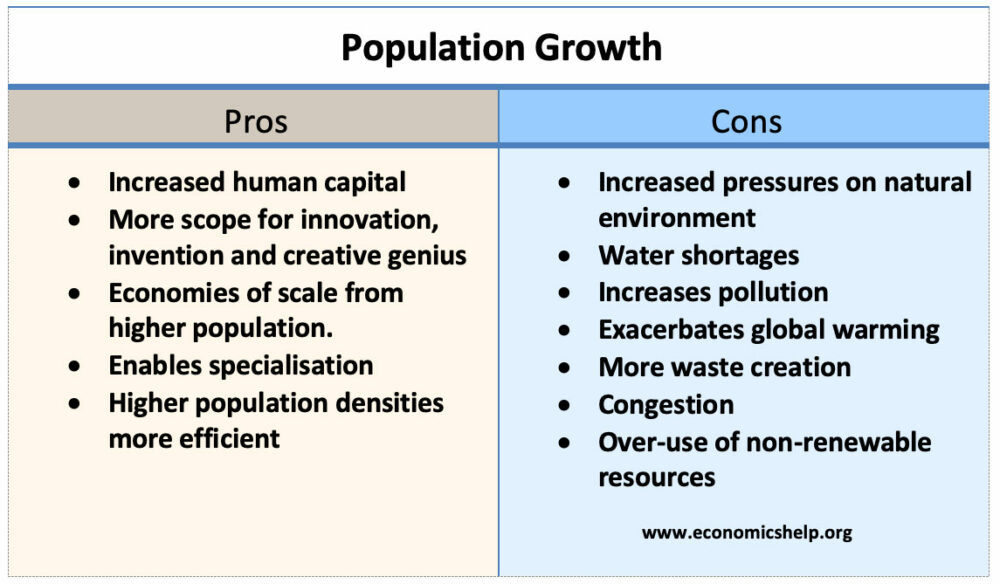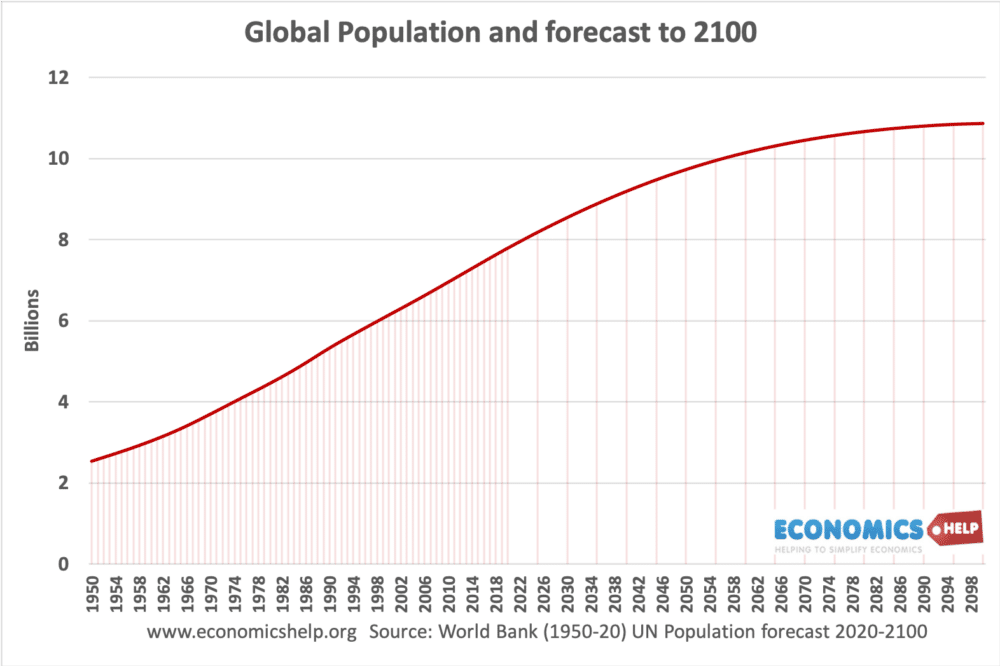Throughout the span of history, the world has seen fast populace development. It has empowered a rich variety of culture, innovation and worked on expectations for everyday comforts. Notwithstanding, populace development is progressively including some significant pitfalls - specifically to the climate. High populace levels are adding to the exhaustion of normal assets and causing broad contamination. Some apprehension populace development is currently profoundly harming for both the planet and, surprisingly, the endurance of numerous normal living spaces. Nonetheless, others contend that fears other populace development are lost with the planet having space for additional individuals, insofar as we figure out how to live more as one with nature and all the more proficiently in enormous urban communities.
ADVANTAGES OF POPULATION GROWTH
1. More individuals prompts more prominent human resources. On the off chance that there are more individuals, the likelihood of finding a virtuoso like Einsterin, Marie Curie, Beethoven increment. These remarkable individuals can prompt innovative and social works of art which enhance our lives. The beyond 200 years have shown outstanding development in specialized improvement and advancement. There are many variables behind this, however the world's developing populace implies we have a greater pool of human resources and the chance of these state of the art disclosures increment.
2. Higher financial development. Populace development will prompt financial development with additional individuals ready to deliver more products. It will prompt higher expense incomes which can be spent on open merchandise, for example, medical care and natural tasks.
- The undeniable assessment is to say, the pivotal thing isn't GDP, yet GDP per capita. On the off chance that monetary development is at similar rate as populace development, normal expectations for everyday comforts won't increment. In any case, it is conceivable populace development can likewise work on per capita livelihoods. As the populace expands, the economy can profit from a greater ability pool, economies of scale and more noteworthy specialization. This can empower higher per capita pay, which we have found in major created economies.
3. Economies of scale. Cultivating and industry have had the option to profit from economies of scale, and that implies as the populace develops, food result and assembling yield have had the option to develop much quicker than populace development. For instance, at the turn of the nineteenth hundred years, Thomas Malthus anticipated populace development would prompt starvation as we would not be able to take care of the developing populace. Notwithstanding, his critical expectations neglected to appear on the grounds that he neglected to comprehend, that the efficiency of land, work and capital could all increment more than proportionately. quite a while back, the vast majority of the populace dealt with the land. Mechanical advancement and economies of scale, mean efficiency of land has incomprehensibly expanded as ranchers utilize motorization and economies of scale for expanded food creation.
4. The productivity of higher population density. As far according to capita carbon impression, regions with a high populace thickness are fundamentally more effective than provincial regions and spots with a low populace. At the point when individuals live in thickly populated regions, they are bound to utilize public vehicle, live in apartment complexes which are more straightforward to warm. In huge urban communities, transport and the conveyance of merchandise is substantially more effective, though for low populace densities, the typical expense and ecological impression are a lot higher. Hence, populace development which prompts development in city connurbations (which is a component of worldwide development in past) isn't quite as earth harming as we might suspect. In Green Metropolis, by David Owen he contends living in nearer closeness in urban communities is a critical part of manageability
- Metropolitan regions represent just 3% of the world's property surface. Be that as it may, over half of the populace. By 2050, the United Nations anticipate this will ascend to 70%. Consequently, populace development doesn't need to prompt a comparable fall in regular environments.
5. The superior segment design of society. Numerous western economies are currently encountering a falling populace, with the outcome that their populace segment is being slanted to old, retirees. This is forcing costs on society as we battle to pay for medical services and benefits. Moderate populace development serves to rebalance the populace with a higher portion of youthful, working individuals.
6. Higher Minimum amount. Higher populaces can empower a minimum amount of individuals to empower a sider, more dynamic culture. With low populaces, there is less extension for variety. Be that as it may, when the populace develops, it can empower the help of a more extensive social scope of exercises.
DISADVANTAGES OF POPULATION GROWTH
1. Cost to the environment. Population growth exacerbates many of the existing environmental problems
- Attempting to decrease carbon and methane emanations to diminish a worldwide temperature alteration is somewhat more troublesome as the populace.
- There will be more prominent danger on normal living spaces as a more prominent populace has more noteworthy interest for lodging and farmland. This will build strain to chop down timberlands to clear a path for cultivating and lodging.
- Higher populace will prompt a more prominent utilization of non-inexhaustible assets, prompting a quicker consumption of normal assets.
- Higher populace will prompt more prominent contamination levels in air, water and land. Higher contamination is related with a scope of medical problems, like malignant growth and asthma. The contamination likewise hurts creatures and plants.
- Soil debasement. To take care of a developing planet, we have seen serious debasing of farmland (as indicated by UN gauges) around 12 million hectares of farmland consistently. This is because of variables, for example, overgrazing, utilization of synthetics, environmental change and utilization of synthetic substances.
2. Congestion. Such a large number of individuals in a little space will prompt different sorts of blockage. Street blockage is a significant issue across the world. One review proposed clog cost the EU €111bn (1% of GDP) in 2012. WIth populace development, the expenses of clog will just expand prompting time lost, more contamination and lost yield.
3. Water shortages. Currently up to 40% of the total populace face water shortage and the gamble of dry season. As per the UN water deficiencies could prompt 700 million individuals at the gamble of removal. A developing populace will come down on scant water supplies and this is an element behind numerous minor and significant struggles with nations tracking down strategies for getting around the deficiency of water.
4. Generating unsustainable waste. We are right now creating non-biodegradable waste that we are battling to process. It will in general end in landfill, causing methane emanations and other poisonous issues.
THE CAUSES OF RAPID POPULATION GROWTH
Today the Earth is home to more than 7.8 billion individuals. By 2100 the populace is on target to hit 10.8 billion, as per the United Nations — and that is accepting consistent fruitfulness decreases in numerous nations. Strangely, in the event that additional headway is made in ladies' regenerative self-assurance, and richness falls more than the United Nations accepts at least for now that is logical, the populace in 2100 may be a generally more modest 7.3 billion.
For the present, the total populace is as yet expanding in immense yearly augmentations (around 80 million every year), and our stock of fundamental non-sustainable assets are being depleted. Many elements add to these unreasonable patterns, including falling death rates, underutilized contraception, and an absence of instruction for young ladies.
FALLING MORTALITY RATE
The essential (and maybe generally self-evident) reason for populace development is an irregularity among births and passings. The baby death rate has diminished universally, with 4.1 million newborn child passings in 2017 contrasted with 8.8 million of every 1990, as per the World Health Organization (WHO). This is welcome general wellbeing news, obviously.
Simultaneously, life expectancies are expanding all over the planet. We who are alive today will probably live significantly longer than the vast majority of our predecessors. Worldwide normal future has dramatically increased beginning around 1900, on account of progressions in medication, innovation, and general cleanliness. Falling death rates are unquestionably nothing to grumble about either, however broad life span adds to the arithmetic of expanding populace numbers.
UNDERUTILIZED CONTRACEPTION
The worldwide richness rate has fallen consistently throughout the long term, down from a normal of 5 youngsters for each lady in 1950 to 2.4 kids for every lady today, as per the UN Population Division. Alongside that promising pattern, preventative use has gradually however consistently expanded worldwide, ascending from 54% in 1990 to 57.4% in 2015. However, all in all, preventative use is still underutilized. For instance, as per the WHO, an expected 214 million ladies in emerging nations who need to stay away from pregnancy are not utilizing current contraceptives.
These ladies aren't involving contraceptives for different reasons, including normal practices or strict convictions that deter conception prevention, misguided judgments about unfavorable incidental effects, and an absence of organization for ladies to pursue choices around sex and family arranging. An expected 44% of pregnancies were accidental overall between 2010-2014. Getting more ladies the entrance and organization to use family arranging strategies could go far in smoothing the populace bend.
Absence OF FEMALE EDUCATION
Albeit female admittance to training has expanded throughout the long term, the orientation hole remains. Approximately 130 million young ladies overall are out of school as of now, and an expected 15 million young ladies of grade young won't ever figure out how to peruse and compose, contrasted and 10 million young men.
Expanding and empowering schooling among ladies and young ladies can have various positive gradually expanding influences, including postponed childbearing, better kids, and an expansion in labor force support. A lot of proof proposes a negative connection between's female schooling and ripeness rates.
In the event that expanded female training can postpone or diminish richness and give young ladies open doors past an early marriage, it could likewise assist with relieving current populace patterns.

WHAT CAN BE DONE?
While tending to overpopulation, it's vital to adopt a strategy of giving strengthening while at the same time preparing against anyone upholding for the utilization of pressure or viciousness to take care of our concerns. The joined endeavors of spreading information about family arranging, expanding organization among ladies, and exposing broadly held fantasies about contraception will quantifiably steer the total populace.
As we do our work at Population Media Center (PMC), we see direct that spreading mindfulness about family arranging strategies and the environmental and financial advantages of having more modest families can change regenerative way of behaving. For instance, audience members of our Burundian public broadcast Agashi ("Hey! Look Again!") were 1.7 times more probable than non-audience members to affirm that they were able to arrange condom use with a sexual accomplice and 1.8 times more probable than non-audience members to say that they by and large support family anticipating restricting the quantity of kids.
At PMC we outfit the force of narrating to engage audience members to carry on with better and more prosperous lives, which thusly adds to balancing out the worldwide populace so that individuals can live reasonably with the world's inexhaustible assets. Find how PMC is making a move against overpopulation today!






